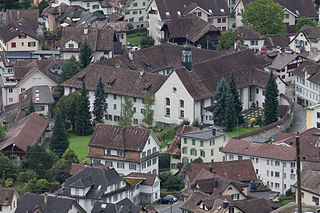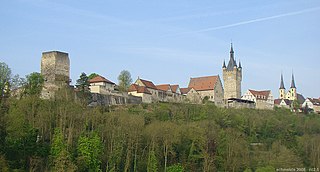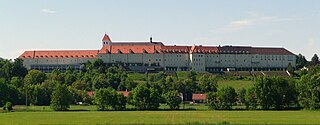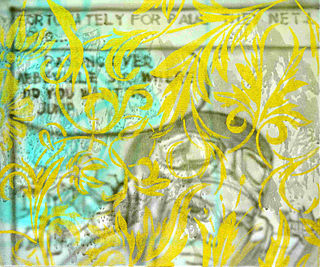


The Katharinenhof in Kranenburg, North Rhine-Westphalia, Germany, was used from 1446 until 1802 as the home of a convent of sisters of the Catholic Church. After that time, the building served various uses. Since 1961, the house serves as a museum.



The Katharinenhof in Kranenburg, North Rhine-Westphalia, Germany, was used from 1446 until 1802 as the home of a convent of sisters of the Catholic Church. After that time, the building served various uses. Since 1961, the house serves as a museum.
It was in 1445 that Henrik Housteen, who then was the chef of the kitchen of the duke of Kleve, donated to the nuns the house in the millstreet (Mühlenstraße) in Kranenburg, so that they could found a subsidiary of their convent there. In 1446 the convent moved with the approval of the duke to that house. In 1472 the sisters adopted the Rule of St. Augustine. In 1802 the Katharinen-convent was secularized.
After the convent was closed, the monastery-building served temporarily as a police office and finally was furbished up to be used as a school-building. During the Drittes Reich it was the accommodation of the NSV-kindergarten.
NSV stands for Nationalistische Volkswohlfahrt. After the Second World War the building, which was only shopworn, was used as a compensatory church. In 1959/1960 the premises were thoroughly renovated. Since 1961 it is the home of the Museum Katharinenhof. Owner of the museum is the Verein Für Heimatschutz 1922 e. V., Kranenburg. In 1984 the building got an outbuilding, which allows for a larger exhibition space of the museum.

The town of Schwyz is the capital of the canton of Schwyz in Switzerland.

Bad Wimpfen is a historic spa town in the district of Heilbronn in the Baden-Württemberg region of southern Germany. It lies north of the city of Heilbronn, on the river Neckar.

Burtscheid Abbey was a Benedictine monastery, after 1220 a Cistercian nunnery, located at Burtscheid, near Aachen, North Rhine-Westphalia, in Germany.

The Comburg is a former Benedictine monastery near Schwäbisch Hall, Germany.

Mallersdorf Abbey was formerly a monastery of the Benedictine Order and is now a Franciscan convent in Mallersdorf-Pfaffenberg in Bavaria.

Kranenburg is a town and municipality in the district of Cleves in the state of North Rhine-Westphalia, Germany. It is located near the border with the Netherlands, 12 kilometres (7 mi) south-east of Nijmegen and 11 kilometres (7 mi) west of Cleves.

Georgsmarienhütte is a town in the district of Osnabrück, in Lower Saxony, Germany. It is situated in the Teutoburg Forest, approx. 7 km south of Osnabrück.

Wettenhausen Abbey was an Imperial Abbey of Augustinian Canons until its secularization in 1802–1803. Being one of the 40-odd self-ruling Imperial Abbeys of the Holy Roman Empire, Wettenhaussen Abbey was a virtually independent state. Its abbot had seat and voice in the Imperial Diet, where he sat on the Bench of the Prelates of Swabia. At the time of secularization, the Abbey's territory covered 56 square kilometers and it had about 5,400 subjects.

Baindt Abbey, otherwise the Imperial Abbey of Baindt, was a Cistercian nunnery in Baindt in the district of Ravensburg in Baden-Württemberg, Germany.

Steinfeld Abbey is a former Premonstratensian monastery, now a Salvatorian convent, with an important basilica, in Steinfeld in Kall, North Rhine-Westphalia, Germany.

Lüne Abbey is a former Benedictine nunnery in the Lower Saxon town of Lüneburg. Today it is a Protestant Lutheran convent and is managed by the Klosterkammer Hannover. The current abbess is Reinhild Freifrau von der Goltz.

Lissingen Castle is a well-preserved former moated castle dating to the 13th century. It is located on the River Kyll in Gerolstein in the administrative district of Vulkaneifel in Rhineland-Palatinate, Germany. From the outside it appears to be a single unit, but it is a double castle; an estate division in 1559 created the so-called lower castle and upper castle, which continue to have separate owners. Together with Bürresheim and Eltz, it has the distinction among castles in the Eifel of never having been destroyed.

The Liebenau monastery was a Dominican monastery. It was located outside the city gates of Worms in today's Worms-Hochheim district.

The Märkisches Museum is a museum in Mitte, Berlin. Founded in 1874 as the museum of the city of Berlin and its political region, the March of Brandenburg, it occupies a building on the northern edge of Köllnischer Park, facing the Spree, which was designed by Ludwig Hoffmann and completed in 1908. It is now the main facility of the Stiftung Stadtmuseum Berlin, Landesmuseum für Kultur und Geschichte Berlins, the City of Berlin museum foundation, which also operates four other sites.

Burg Zelem or Zelem Castle was a knight's moated fortress located in the lowland areas left of the Rhine River between the villages Mehr and Niel in the present Gemeinde of Kranenburg.


The Altenberger Dom is the former abbey church of Altenberg Abbey which was built from 1259 in Gothic style by Cistercians. Listed as a cultural heritage, it is located in Altenberg, now part of Odenthal in the Rheinisch-Bergischer Kreis, North Rhine-Westphalia, Germany. Until 1511, the church was the burial site of counts and dukes of Berg and the dukes of Jülich-Berg.

Horst Keining is a German visual artist.

Heimatschutz Architecture, or the Heimatschutzstil or Heimatstil is a style of architectural modernism that was first described in 1904 and had its prime until 1945. Various buildings were built after the war until around 1960. The main areas of work were settlement building, house building, garden design, industrial building, church building and monument preservation.